Overview
- Bob Jones, an owner of public relations firm, learns that he has kidney cancer and that his wife, Gail Jones, is pregnant.
- Bob makes movies to immortalize himself.
- He interacts with the family and care providers.
- Cultural, ethical, and personal issues are present (“My Life,” 1993).
“My Life” is a movie that shows how a person receives both good and bad news and confronts the end of life. Due to kidney cancer, Bob is told that he will live about 4 more months and will die before the birth of his child. After trying conventional therapies to treat cancer, his wife urges Bob to visit Mr. Ho, a Chinese healer, who explains to him that he should learn to forgive and stop his aggressiveness. It turns out that Bob is able to cope with his feelings and then dies in peace and love after seeing his newborn son.
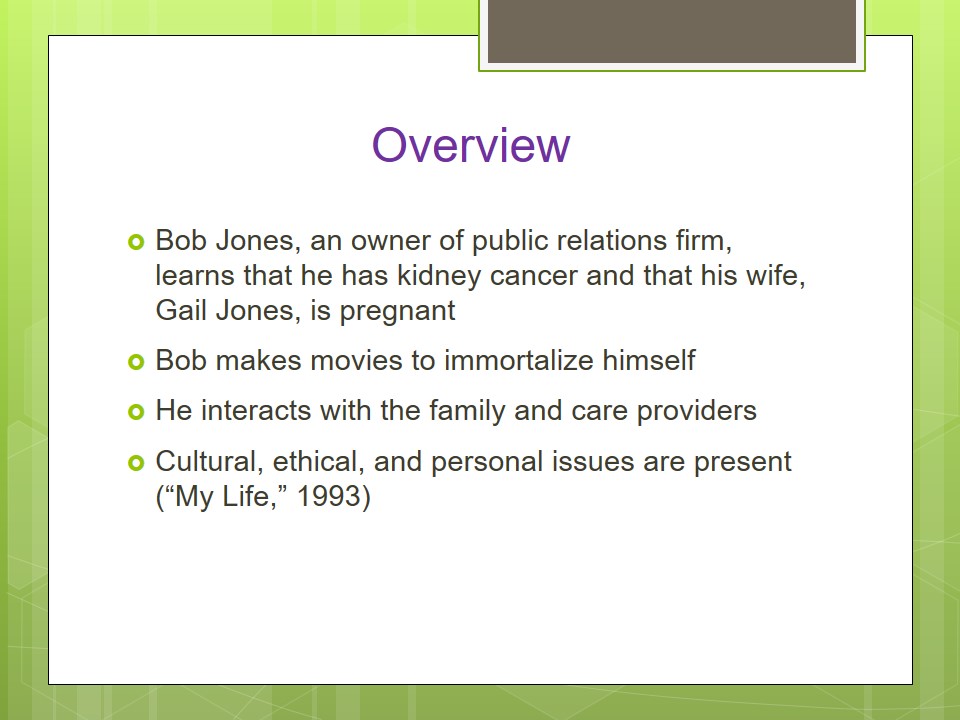
Quality of Palliative Care
- Palliative care was provided.
- No hospice.
- A live-in nurse helps Bob.
- Quality of care is appropriate as it fully meets the needs of the patient (Itano, Brant, Conde, & Saria, 2015).
Speaking of the quality of palliative care provided to Bob in this movie, it is important to note that he talks to several experts, all of whom respond to his questions and concerns professionally. Bob’s wife accompanies him during the visits to the specialists, who speak in a very polite, responsive, and understandable manner. For example, when Bob rejects his diagnosis and cries, they remain composed and respectful. They suggest appropriate therapies and clearly explain to the patient that his condition is critical. A live-in nurse also shows great responsibility while caring for Bob and interacting with Gail, who also actively participates in palliative care.
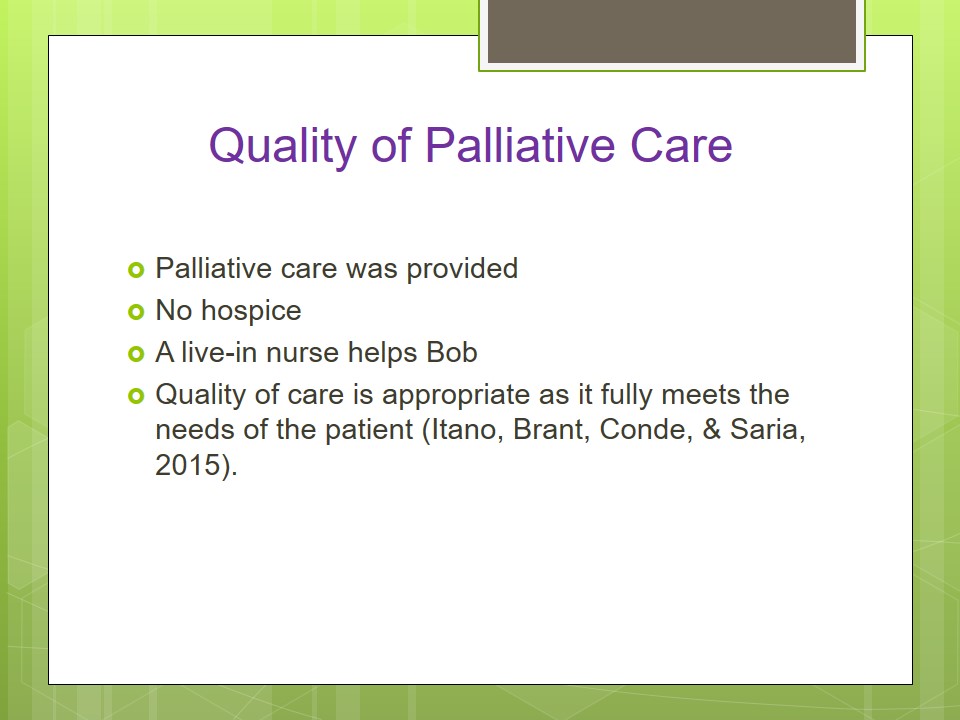
Pain
- Physical pain:
- Cancer and metastases;
- Pain relievers;
- Antidepressants (Panke, 2002).
- Emotional pain:
- Fear and anger;
- Self-destruction;
- Closeness;
- Communication.
Pain is shown in the movie based on Bob’s physical suffering and his emotional problems. Physical pain increases with the course of the disease, yet it is addressed properly, and there are no scenes that depict concerns or complaints regarding pain. Also, the last doctor clearly states that he will provide a full range of necessary services, including medication for pain relief (the type of medication is not specified). In turn, emotional pain is expressed through Bob’s personality features and his internal resistance to forgiving his family, which is handled by means of communication. Pain impacts the character’s death as a facilitator of his awareness of the value and meaning of his life. It also allows the family members to overcome their previous feelings of being offended so that they are able to visit Bob in California.
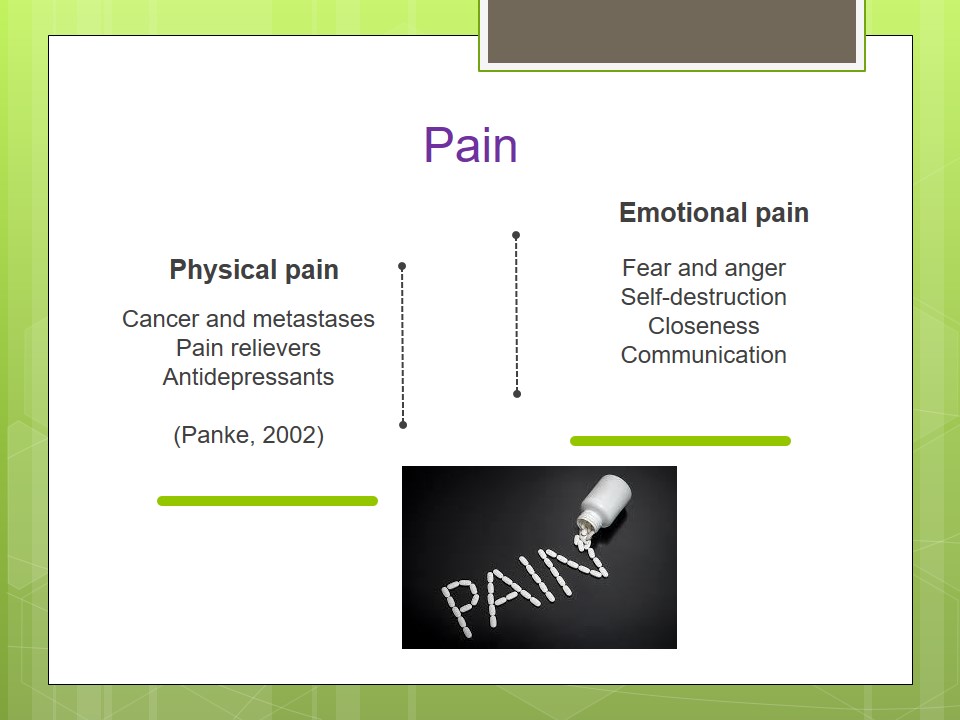
Signs and Symptoms of Death
- Cough;
- Depression;
- Fatigue;
- Pain;
- Insomnia;
- Anxiety.
The movie shows various signs and symptoms of death that Bob faces. With the deterioration of his condition, the main character experiences pain in the area of his kidneys, anxiety, depression, and other symptoms presented here on the slide. For example, he almost loses the ability to sleep and has to watch television to pass the long nights. Interventions such as psychological and physical therapies were implemented. In particular, the patient received suppressants/expectorants, antidepressants, non-traditional Chinese healing, empathetic listening, and support. Even though all these interventions are supposed to be provided by an interdisciplinary team, care professionals often did not communicate with each other. A team approach is poorly applied in this movie.
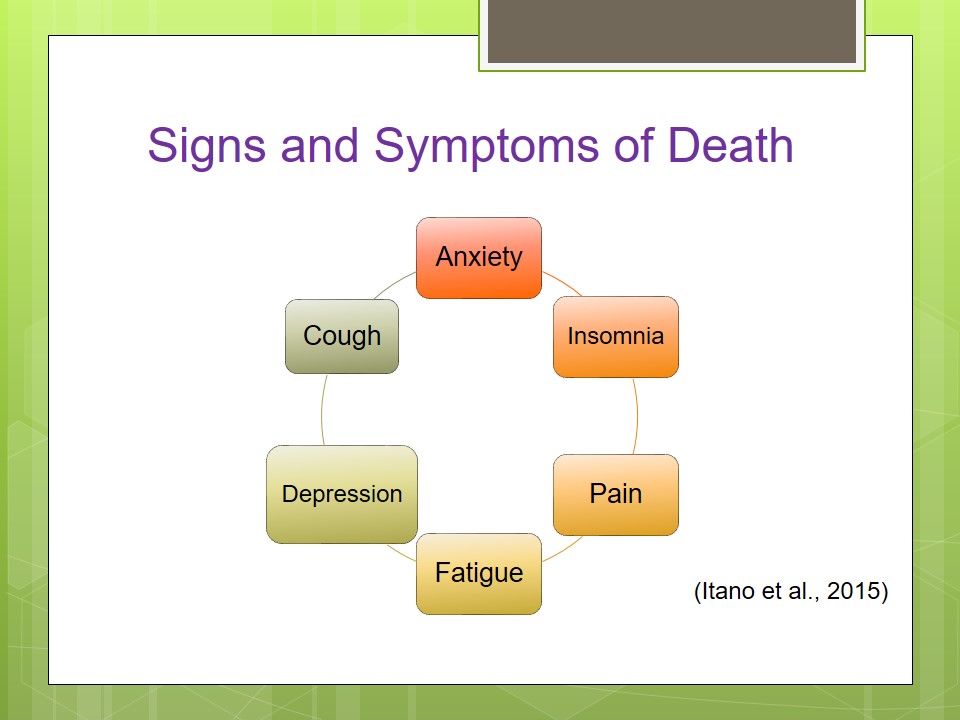
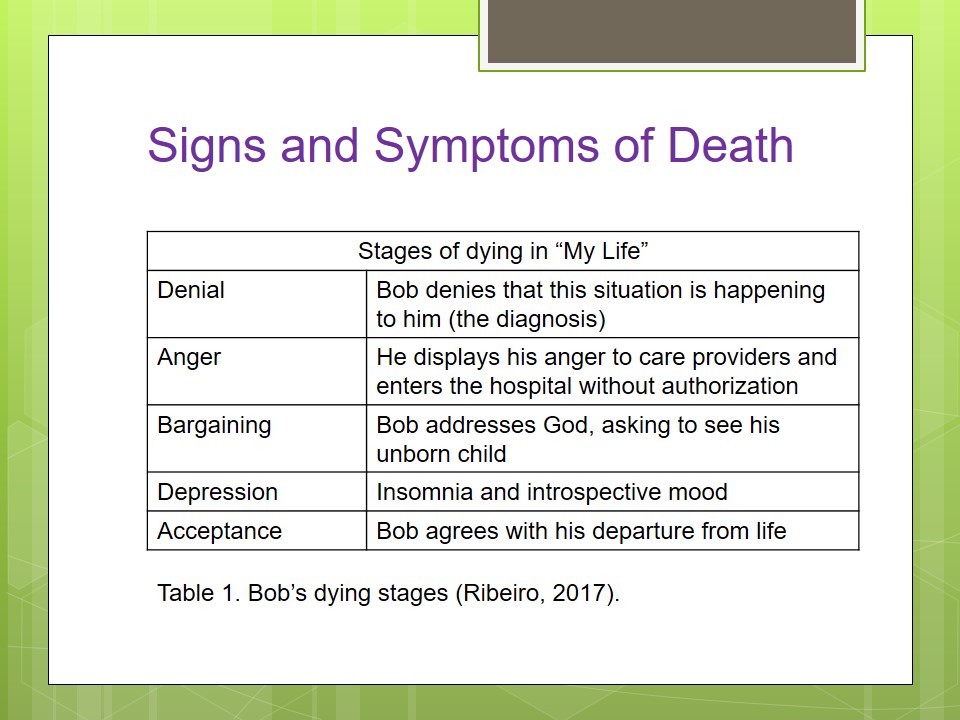
Cultural Issues
The cultural issues related to Bob’s end-of-life are associated with his attitudes to his family and his origins. Since he wanted to hide his cultural roots, the main character had reduced contact and failed to communicate with his brother and father when they met. This issue causes anger and fear because a person without an ethnic identity cannot feel secure and belonging to a family. Gail and the Chinese healer both contribute to addressing this issue and helping Bob to make peace with his family and accept his ethnicity. Most importantly, his newborn son was perceived by Bob as one of the people who established his own meaning and role in life. The last scene where Bob whispers to his sleeping son demonstrates how deep Bob’s comprehension of life is in general.
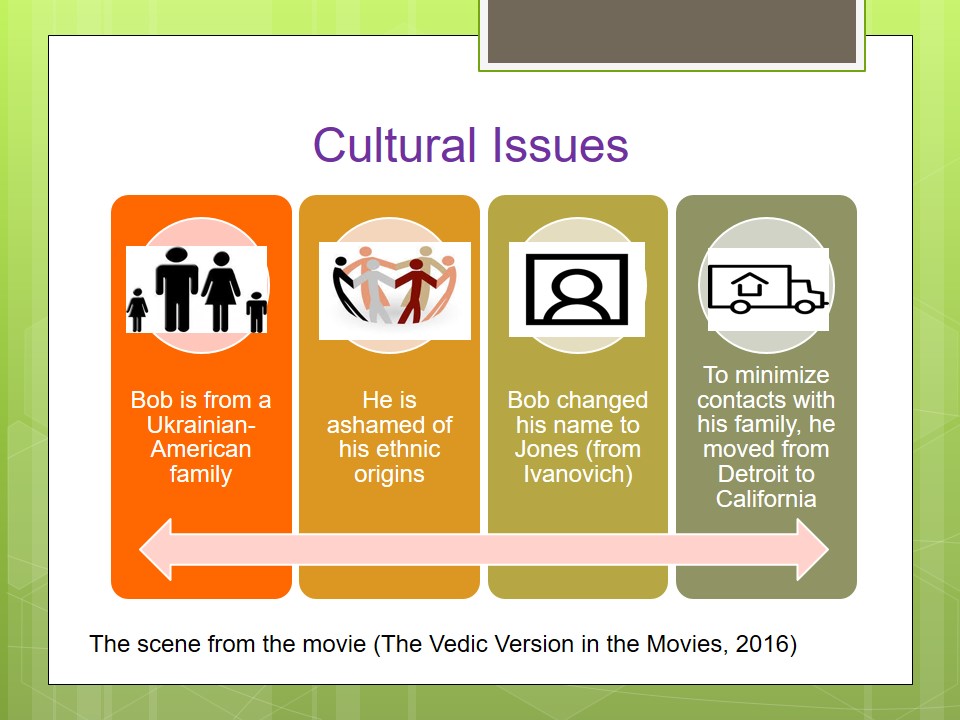
Ethical Decisions
- To be or not to be?
- To tell the truth or support patients’ misconceptions?
- “Healthcare personnel should not deny families the right to believe in miracles” (Maroon, 2012, p. 115).
It is always an ethical dilemma whether to tell the truth to a patient or to support his or her right to believe in miracles. In this case, Bob desperately seeks possibilities for survival and asks doctors about other therapies and medication that might be used on him. For the doctors, it is clear that this patient has no chance to survive, and his life will last about 4 months. Both doctors decided to state the patient’s expected lifespan, and it seems to be ethically correct. This solution allows Bob to reconsider his relationships and views on the most important issues. Instead of spending his limited time trying new medications that could literally kill him, he concentrated on his wife, son, and parents. It was also ethical to call the family, who came to see their loved one for the last time.
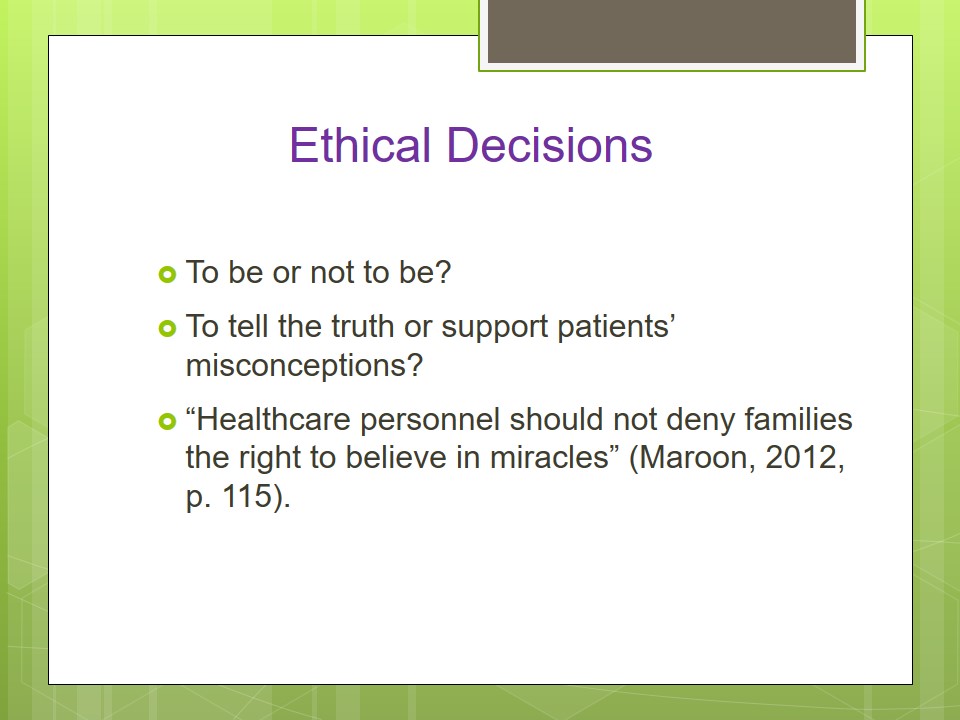
Communication
- Family:
- Wife;
- Parents;
- Brother and his wife;
- Openness;
- Trust;
- Sincerity(Itano et al., 2015).
- Friends:
- Colleagues;
- Nothing good or bad about Bob;
- Care Providers:
- Physicians;
- Nurses;
- Listening;
- Competent services.
- Personally, I would try to help Bob by motivating him more to improve his relationships with his family members (Ferrell, Malloy, Mazanec, & Virani, 2016).
At the beginning of “My Life”, Bob had problems communicating with all the people around him. In one of the scenes where Gail discovers that her husband is filming videos for his son, she reproaches him for closing himself off to her. Also, she asks Bob to share his feelings so that they can handle them together. After that, their relationships become more transparent and Bob learns to trust his wife. After 20 years of minimal contact with his family, Bob starts to value them as an integral part of his life, and Gail assists in it. Communication with colleagues is shown only in the first part of the film, and it is not evident whether he has friends or not. As for his interaction with care providers, Bob changes his opinion regarding them throughout the film. If the doctors and the Chinese healer were first perceived as ignoramuses, they are treated as experts and people who can relieve his pain in the final scenes.
In my view, “My Life” depicts the spiritual growth of a man who had long been alienated from his family. Even though he has a perfect wife, his relationships with his parents and brothers are also essential. Therefore, I would put more effort into encouraging Bob to talk to his family if I were a physician or a nurse caring for him. I would clarify in a respectful manner that the last period of life should be used properly: to meet his family and forgive everyone.

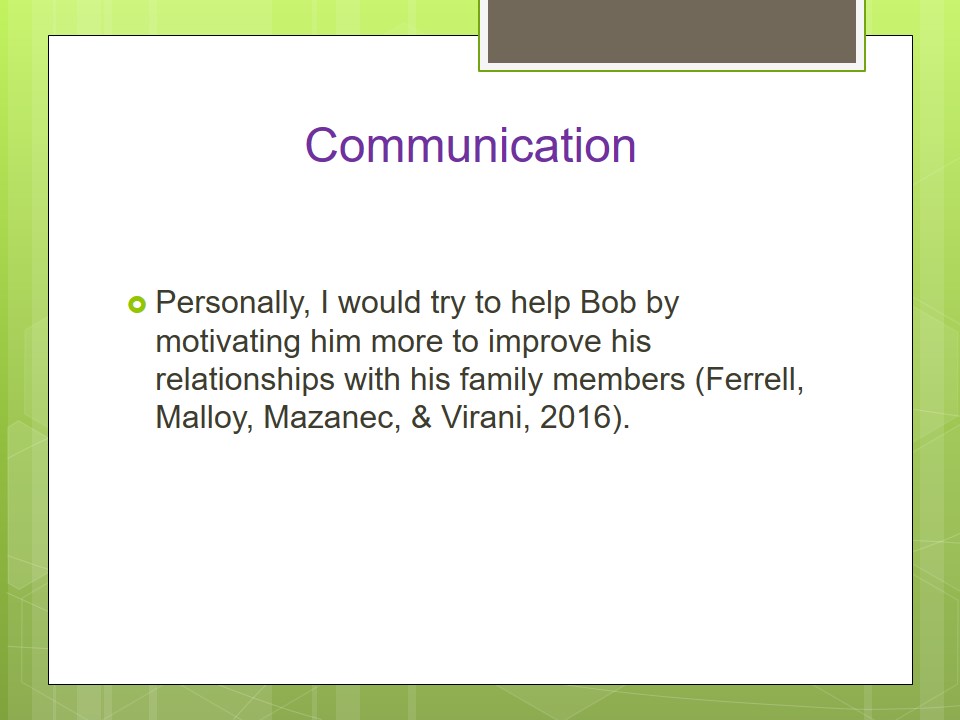
Perceived and Real Losses
- Perceived (Psychological):
- Time spent offending the family;
- Depression;
- Feeling of guilt;
- Real (Physical):
- Loss of life;
- Loss of the family.
Speaking of the losses experienced by Bob, it should be stressed that this patient did not face many of them. Since the movie shows the improvement of his relationships, it becomes evident that his life also becomes better than before the disease in terms of the quality of interactions and losses. For example, one can say that he lost a lot of time when he was not speaking with his family. The losses presented on the slide are managed by means of communication and meeting the health needs of the patient.
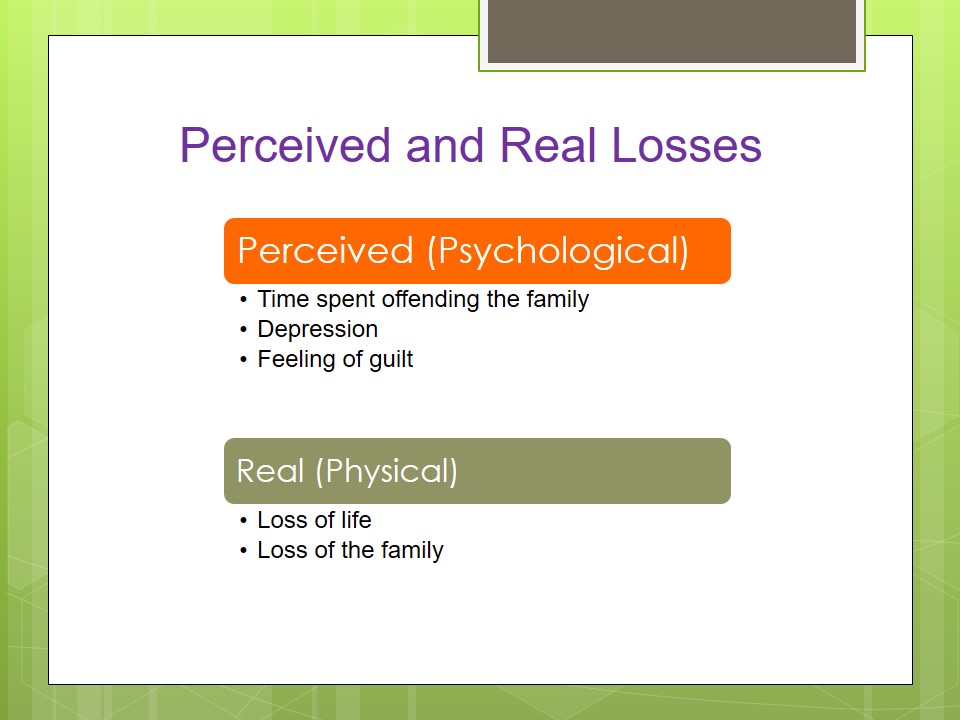
Final Hours
- Gail is near Bob;
- Bob’s father shaves him;
- All characters express sincere love;
- Bob dies in peace (Adam, 1997).
During his final hours, Bob is surrounded with attention and care, which is regarded as the most valuable environment for those who are in a terminal stage of a chronic disease. As stated by Adam (1997), the last hours should be spent in full confidence that a person did his or her best to live a good life. In this case, Bob’s environment is appropriate for his last hours.

Surprising Issues
- ↑Relatively rapid understanding of the fact that Bob was not correct in his previous views.
- ↓Extremely rapid disease development and death.
It was surprising to me that Bob’s disease progressed so quickly and led to his death within several months even though he looked healthy at the beginning of the movie. It goes without saying that I was aware of cancer basics, but “My Life” allowed me to understand the disease better. Also, I was excited to see that Bob achieved reconciliation with his loved ones within such a limited period.
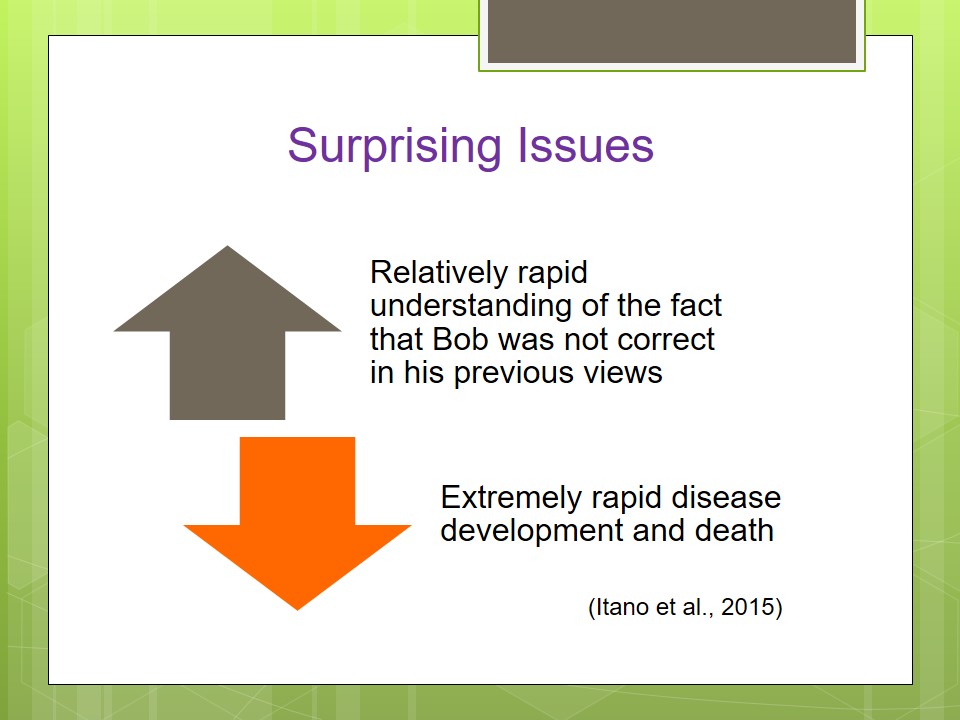
What Could be Done Better?
- A living will of written instructions.
- Be a good listener.
- Discuss the patient’s wishes early.
It seems that this movie describes a quite comprehensive plan of treating a terminally-ill patient. Communication, medication, and the non-traditional therapy provided by the Chinese healer compose the core of care. However, I would also request the patient to draw up a written will so that medical care providers would know how to care for him if he should lose the ability to make rational decisions. Since Bob’s disease also affected his brain, this situation might occur.
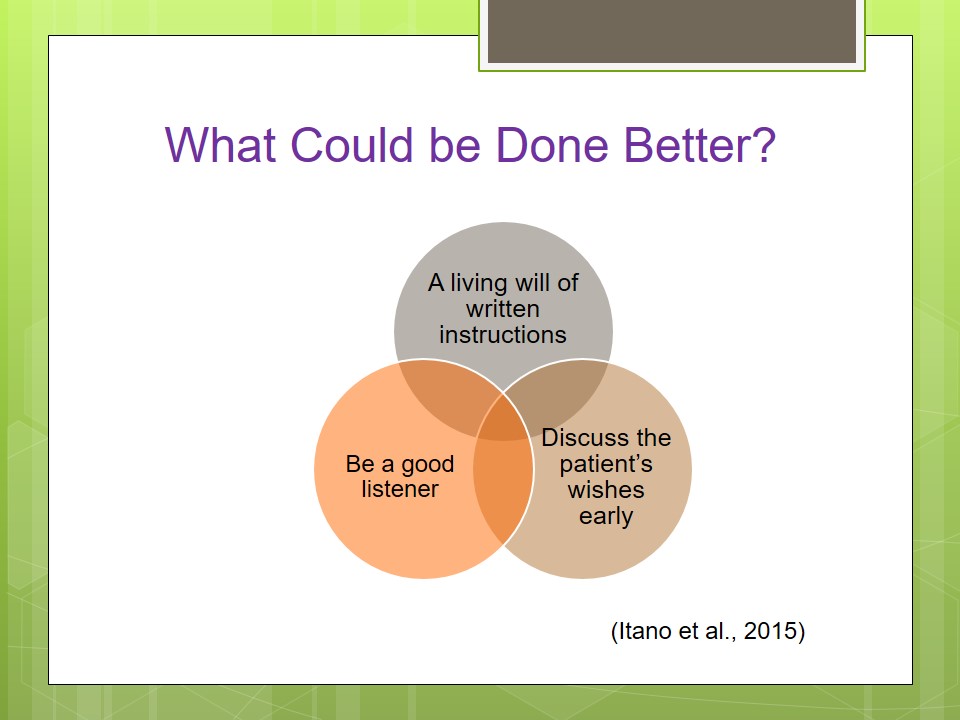
Personal Feelings
- The scene from the movie (iamonlyse7en, 2014).
- Catharsis.
- Dying and death-related processes.
- Combination of medical, psychological, and social assistance.
- Professional palliative care.
- Support of family members.
After reviewing “My Life”, my knowledge of dying and death-related processes increased. I have learned that people change significantly before death and that even the most critical situations can be managed. Personally, I found that the scene about the roller coaster and Bob’s happiness was the most fascinating. Bob and Gail hugged for several moments, and their emotions were pure and honest. It seems that this scene was a moment of catharsis through which the main character qualitatively improved his last days.
In addition, I have learned that dying patients require more attention as they strive to ensure their earthly tasks are completed. People suffering from cancer require special care that combines medical, psychological, and social assistance. Often, after treatment is unsuccessful for one reason or another, the person is left alone with his or her problems. The relatives of a patient in this state also often do not know how to improve the quality their life, help them cope with fears, and ease their pain. Professional palliative care for oncological patients has a positive effect on various aspects of the life of patients and their families. The support of family members was essential for Bob during his chronic illness. This is one of the important components of palliative care. Throughout the entire period of illness, relatives assisted in preparing for the end and, if necessary, continued their support after the death of a family member.
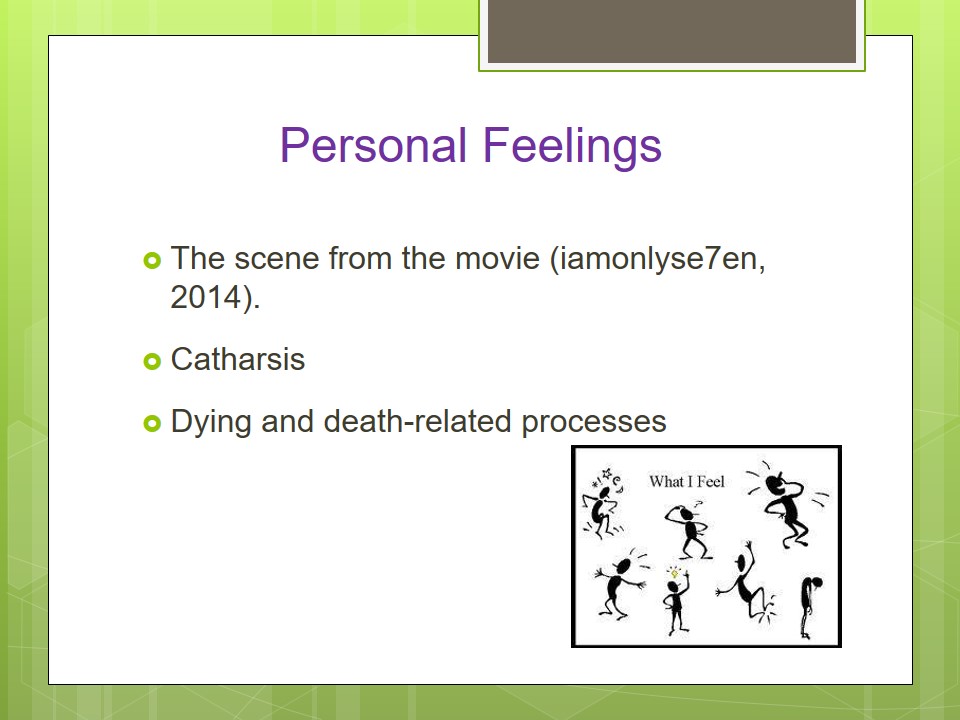
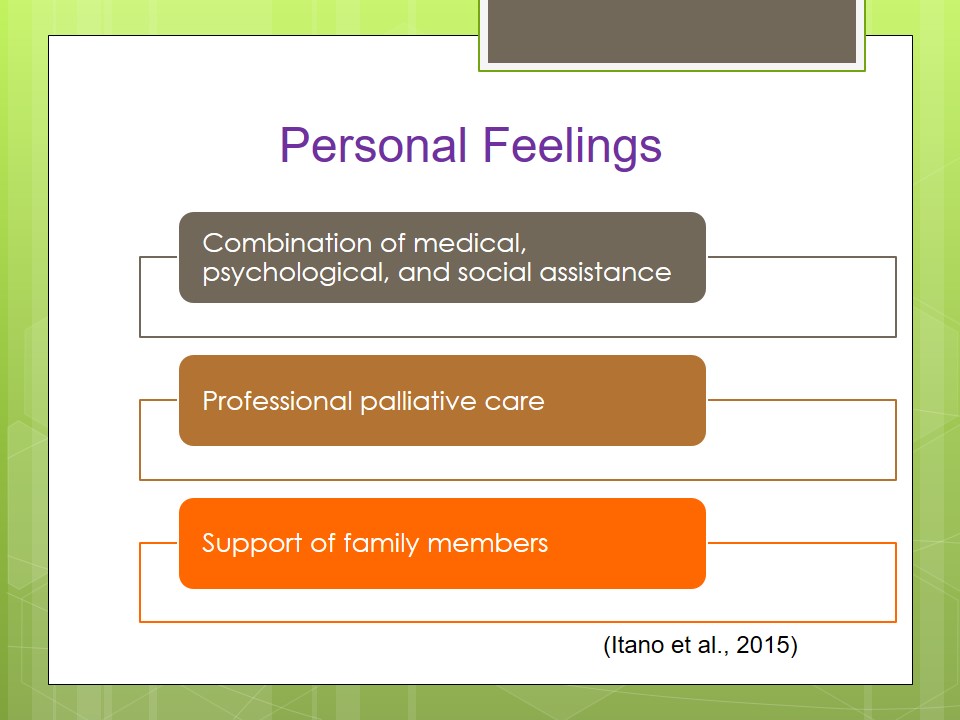
Conclusion
- “My Life” presents the quintessence of palliative care processes to help critically-ill patients manage their pain and have a good quality of life.
- Care providers should support patients’ hopes for a favorable and peaceful outcome.
To conclude, “My Life” shows that friendly communication increases the effectiveness of palliative treatment. A seriously ill person often becomes withdrawn and moves away from former contacts, but this movie is more optimistic. Palliative care specialists are required to have communication skills in a difficult situation. On the one hand, it is necessary to convey to the patient information about his or her condition and prospects as honestly as possible. On the other hand, it is also important to respect his or her hopes for a favorable and peaceful outcome. Future avenues for research might focus on ways to reveal and address possible offended feelings or anger of cancer patients.
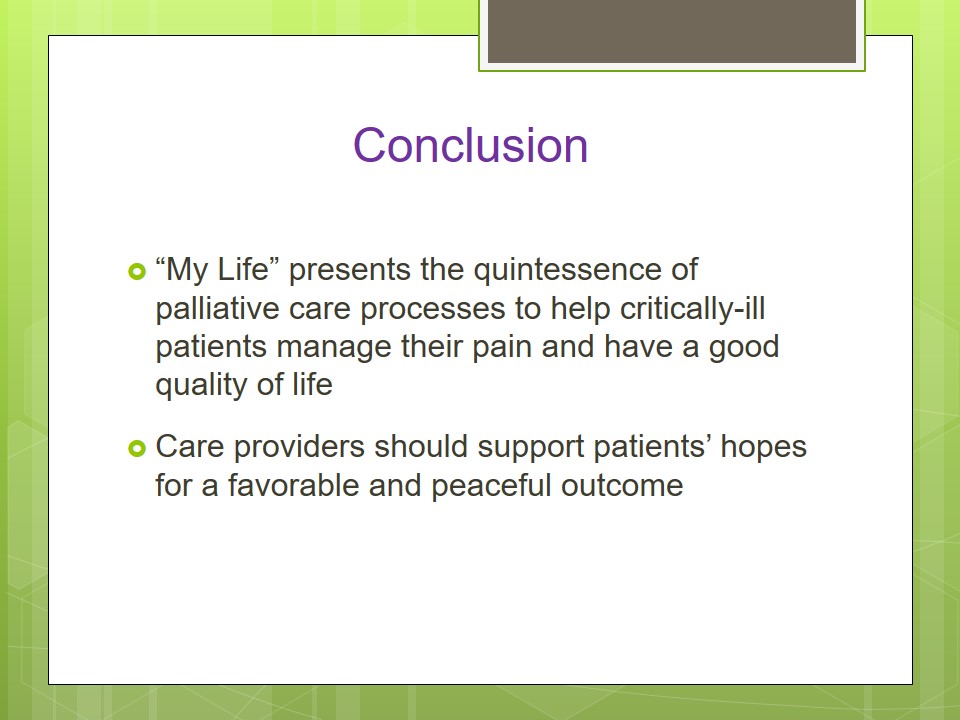
References
Adam, J. (1997). ABC of palliative care: The last 48 hours. BMJ, 315(7122), 1600-1603.
Ferrell, B., Malloy, P., Mazanec, P., & Virani, R. (2016). CARES: AACN’s new competencies and recommendations for educating undergraduate nursing students to improve palliative care. Journal of Professional Nursing, 32(5), 327-333.
iamonlyse7en. (2014). My Life (1993) rollercoaster scene, D-Day [Video file]. Web.
Itano, J. K., Brant, J., Conde, F., & Saria, M. (2015). Core curriculum for oncology nursing (5th ed.). St. Louis, MI: Elsevier Health Sciences.
Maroon, A. M. (2012). Ethical palliative family nursing care: A new concept of caring for patients and families. JONA’S Healthcare Law, Ethics and Regulation, 14(4), 115-121.
My Life. (1993). Web.
Panke, J. T. (2002). CE credit: Difficulties in managing pain at the end of life. The American Journal of Nursing, 102(7), 26-34.
Ribeiro, M. (2017). Analyzing the movie “My Life” under the perspective of the Kübler-Ross. Journal of Palliative Care and Medicine, 7(3), 50.
The Vedic Version in the Movies. (2016). My Life (1993): 29:31 – 31:20 [Video file]. Web.